CBSM 4203: Strategic Information System Report on Malaysian Retail
VerifiedAdded on 2023/01/13
|11
|3308
|43
Report
AI Summary
This report provides a comprehensive analysis of strategic information systems (SIS) within the Malaysian retail industry. It begins by defining SIS and highlighting its importance in enhancing business functions and achieving competitive advantages, particularly in the context of the retail sector's transformation from traditional shops to hypermarkets. The report explores various operational systems, including Transaction Processing Systems, Process Control Systems, and Enterprise Collaboration Systems, detailing their roles in managing day-to-day activities. It also examines management-level systems like Management Information Systems and Decision Support Systems, illustrating their contributions to strategic planning and decision-making. Furthermore, the report discusses the application of Porter's generic model and value chain model, emphasizing their roles in achieving competitive advantages. It also addresses industry barriers that can impede competitiveness. The report concludes by summarizing the key findings and implications of SIS implementation in the dynamic Malaysian retail landscape.
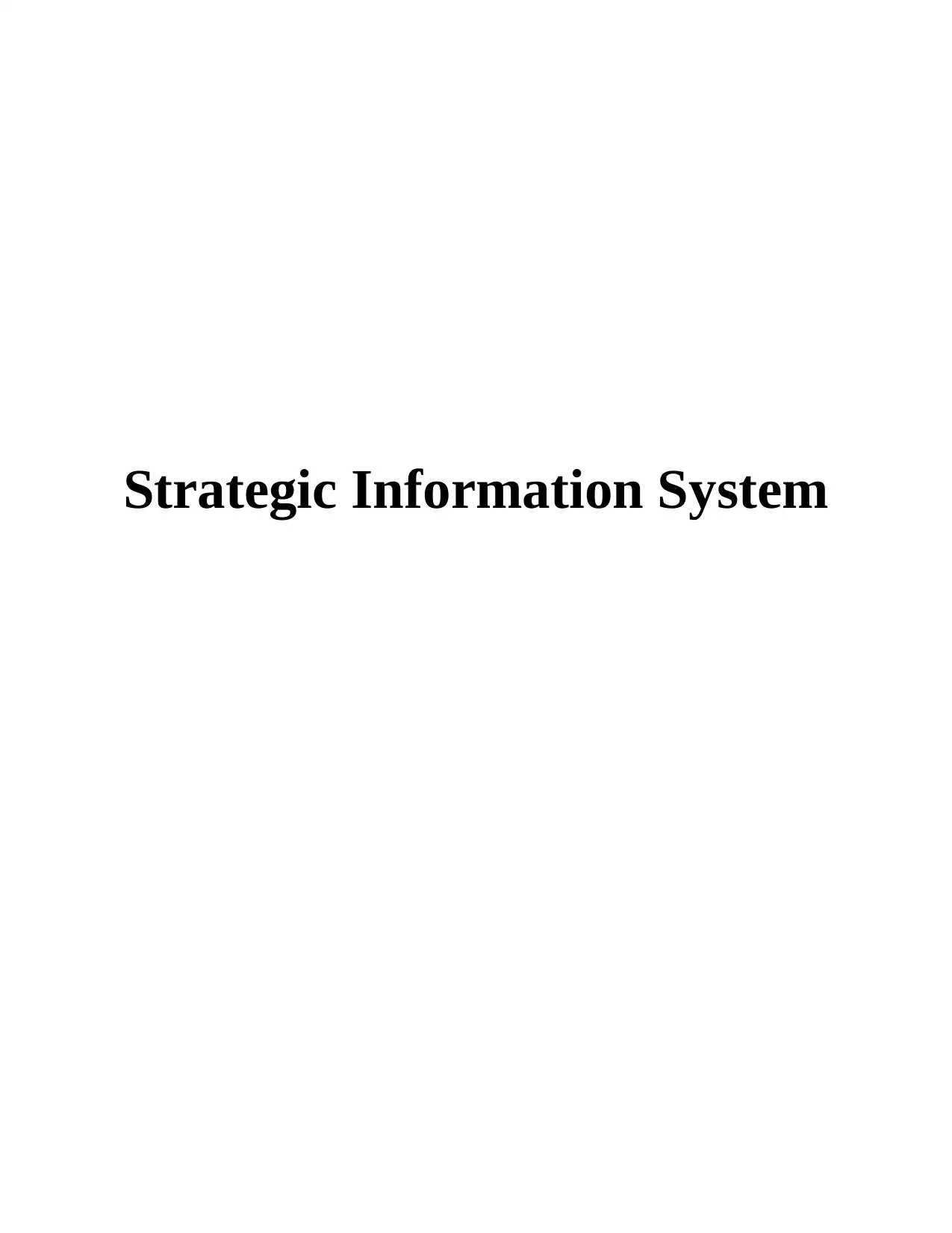
Strategic Information System
Secure Best Marks with AI Grader
Need help grading? Try our AI Grader for instant feedback on your assignments.

Table of Contents
INTRODUCTION...........................................................................................................................3
MAIN BODY...................................................................................................................................3
Definition and importance of strategic information system...................................................3
Description of the usage of different systems and its support at operational level within
businesses...............................................................................................................................4
Description of different systems usage and its support in performance of management or
strategic level functions..........................................................................................................6
Discussion of Porter generic model and its contribution in attainment of competitive
advantage in market................................................................................................................7
Description on the importance of porter value chain model in business................................7
Discussion regarding contribution of primary activities of porter value chain as strategic use
within an organisation............................................................................................................8
Determination of the barriers present in industry and its restrictions to attain competitiveness
in market.................................................................................................................................8
CONCLUSION................................................................................................................................8
REFERENCES................................................................................................................................9
.........................................................................................................................................................9
INTRODUCTION...........................................................................................................................3
MAIN BODY...................................................................................................................................3
Definition and importance of strategic information system...................................................3
Description of the usage of different systems and its support at operational level within
businesses...............................................................................................................................4
Description of different systems usage and its support in performance of management or
strategic level functions..........................................................................................................6
Discussion of Porter generic model and its contribution in attainment of competitive
advantage in market................................................................................................................7
Description on the importance of porter value chain model in business................................7
Discussion regarding contribution of primary activities of porter value chain as strategic use
within an organisation............................................................................................................8
Determination of the barriers present in industry and its restrictions to attain competitiveness
in market.................................................................................................................................8
CONCLUSION................................................................................................................................8
REFERENCES................................................................................................................................9
.........................................................................................................................................................9
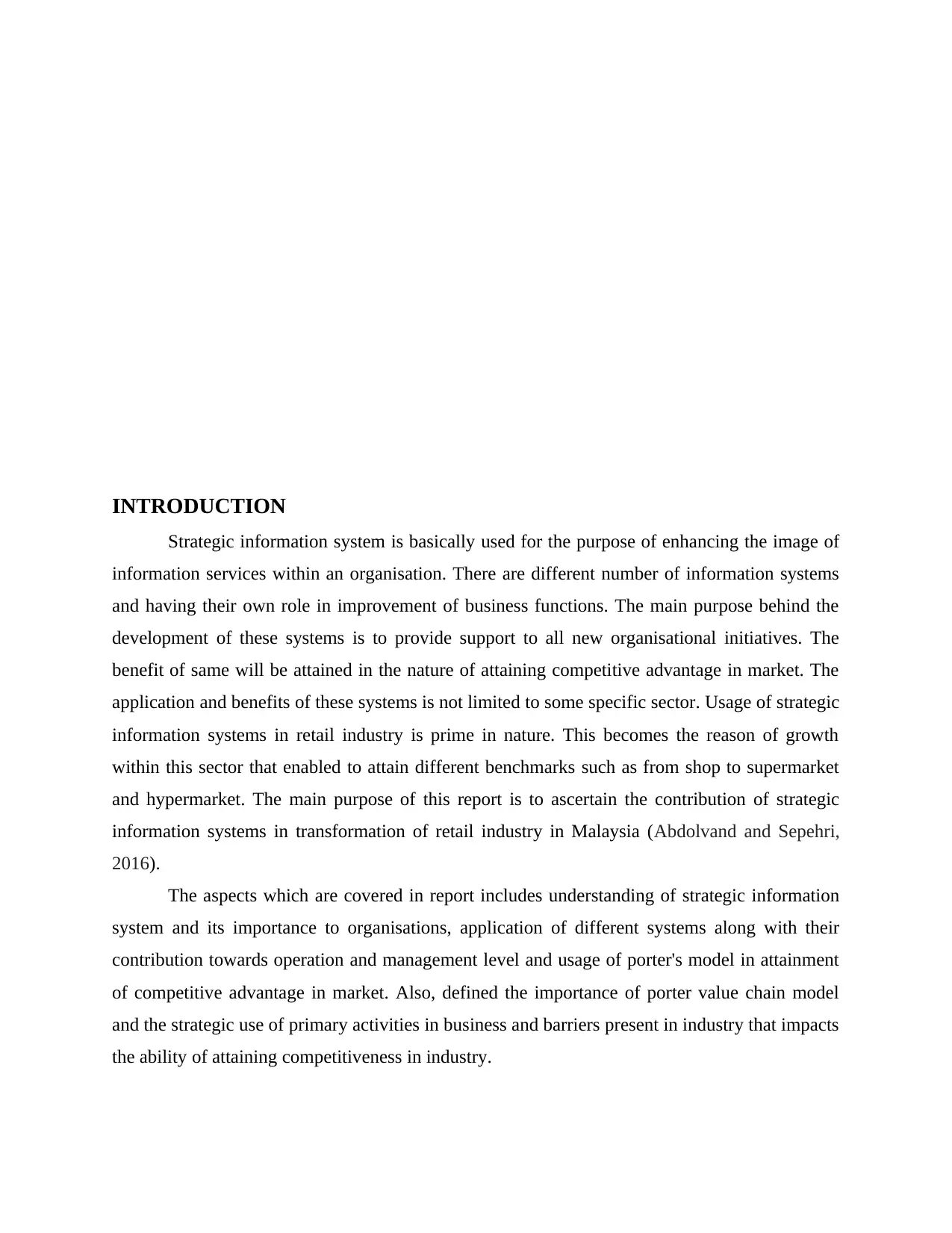
INTRODUCTION
Strategic information system is basically used for the purpose of enhancing the image of
information services within an organisation. There are different number of information systems
and having their own role in improvement of business functions. The main purpose behind the
development of these systems is to provide support to all new organisational initiatives. The
benefit of same will be attained in the nature of attaining competitive advantage in market. The
application and benefits of these systems is not limited to some specific sector. Usage of strategic
information systems in retail industry is prime in nature. This becomes the reason of growth
within this sector that enabled to attain different benchmarks such as from shop to supermarket
and hypermarket. The main purpose of this report is to ascertain the contribution of strategic
information systems in transformation of retail industry in Malaysia (Abdolvand and Sepehri,
2016).
The aspects which are covered in report includes understanding of strategic information
system and its importance to organisations, application of different systems along with their
contribution towards operation and management level and usage of porter's model in attainment
of competitive advantage in market. Also, defined the importance of porter value chain model
and the strategic use of primary activities in business and barriers present in industry that impacts
the ability of attaining competitiveness in industry.
Strategic information system is basically used for the purpose of enhancing the image of
information services within an organisation. There are different number of information systems
and having their own role in improvement of business functions. The main purpose behind the
development of these systems is to provide support to all new organisational initiatives. The
benefit of same will be attained in the nature of attaining competitive advantage in market. The
application and benefits of these systems is not limited to some specific sector. Usage of strategic
information systems in retail industry is prime in nature. This becomes the reason of growth
within this sector that enabled to attain different benchmarks such as from shop to supermarket
and hypermarket. The main purpose of this report is to ascertain the contribution of strategic
information systems in transformation of retail industry in Malaysia (Abdolvand and Sepehri,
2016).
The aspects which are covered in report includes understanding of strategic information
system and its importance to organisations, application of different systems along with their
contribution towards operation and management level and usage of porter's model in attainment
of competitive advantage in market. Also, defined the importance of porter value chain model
and the strategic use of primary activities in business and barriers present in industry that impacts
the ability of attaining competitiveness in industry.
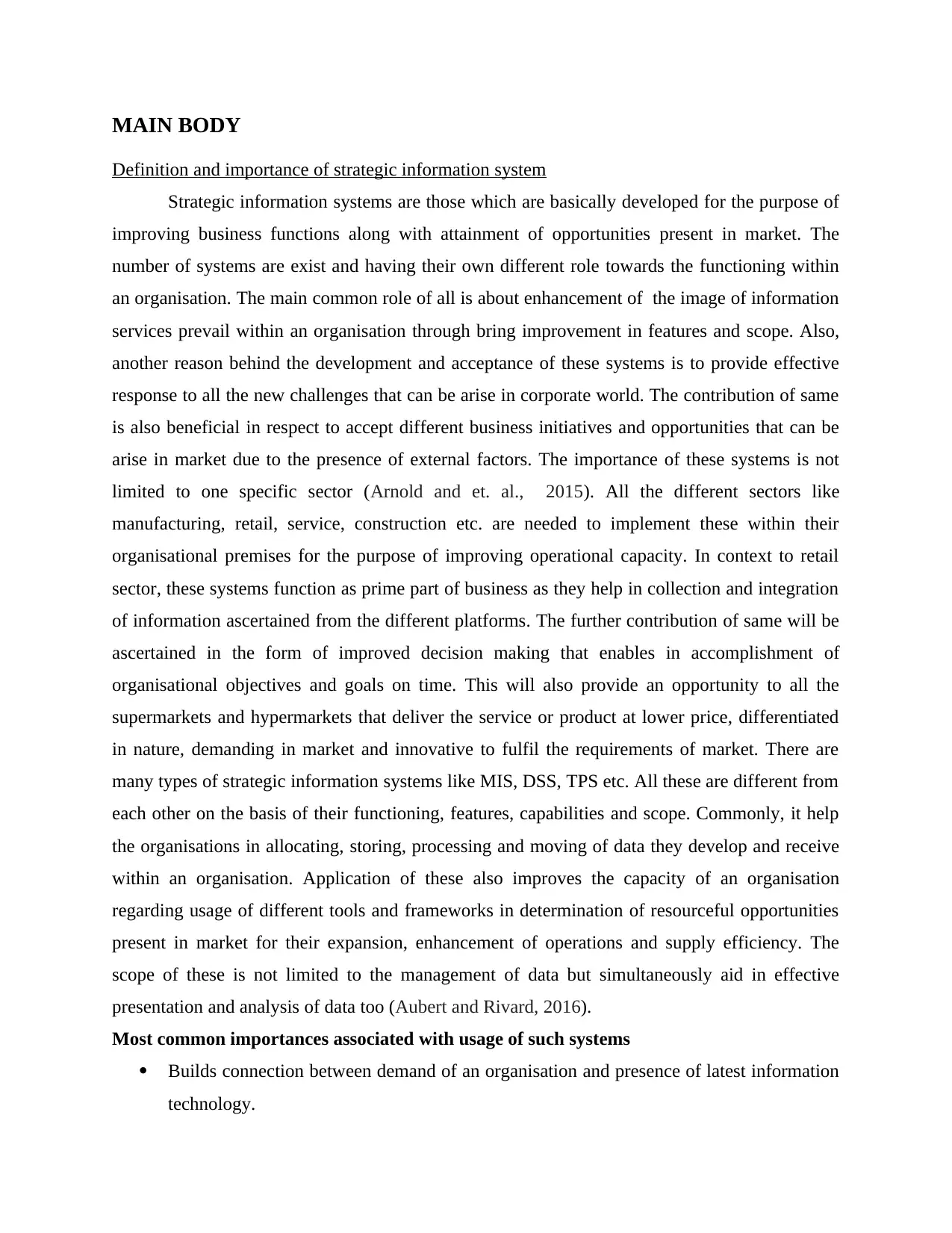
MAIN BODY
Definition and importance of strategic information system
Strategic information systems are those which are basically developed for the purpose of
improving business functions along with attainment of opportunities present in market. The
number of systems are exist and having their own different role towards the functioning within
an organisation. The main common role of all is about enhancement of the image of information
services prevail within an organisation through bring improvement in features and scope. Also,
another reason behind the development and acceptance of these systems is to provide effective
response to all the new challenges that can be arise in corporate world. The contribution of same
is also beneficial in respect to accept different business initiatives and opportunities that can be
arise in market due to the presence of external factors. The importance of these systems is not
limited to one specific sector (Arnold and et. al., 2015). All the different sectors like
manufacturing, retail, service, construction etc. are needed to implement these within their
organisational premises for the purpose of improving operational capacity. In context to retail
sector, these systems function as prime part of business as they help in collection and integration
of information ascertained from the different platforms. The further contribution of same will be
ascertained in the form of improved decision making that enables in accomplishment of
organisational objectives and goals on time. This will also provide an opportunity to all the
supermarkets and hypermarkets that deliver the service or product at lower price, differentiated
in nature, demanding in market and innovative to fulfil the requirements of market. There are
many types of strategic information systems like MIS, DSS, TPS etc. All these are different from
each other on the basis of their functioning, features, capabilities and scope. Commonly, it help
the organisations in allocating, storing, processing and moving of data they develop and receive
within an organisation. Application of these also improves the capacity of an organisation
regarding usage of different tools and frameworks in determination of resourceful opportunities
present in market for their expansion, enhancement of operations and supply efficiency. The
scope of these is not limited to the management of data but simultaneously aid in effective
presentation and analysis of data too (Aubert and Rivard, 2016).
Most common importances associated with usage of such systems
Builds connection between demand of an organisation and presence of latest information
technology.
Definition and importance of strategic information system
Strategic information systems are those which are basically developed for the purpose of
improving business functions along with attainment of opportunities present in market. The
number of systems are exist and having their own different role towards the functioning within
an organisation. The main common role of all is about enhancement of the image of information
services prevail within an organisation through bring improvement in features and scope. Also,
another reason behind the development and acceptance of these systems is to provide effective
response to all the new challenges that can be arise in corporate world. The contribution of same
is also beneficial in respect to accept different business initiatives and opportunities that can be
arise in market due to the presence of external factors. The importance of these systems is not
limited to one specific sector (Arnold and et. al., 2015). All the different sectors like
manufacturing, retail, service, construction etc. are needed to implement these within their
organisational premises for the purpose of improving operational capacity. In context to retail
sector, these systems function as prime part of business as they help in collection and integration
of information ascertained from the different platforms. The further contribution of same will be
ascertained in the form of improved decision making that enables in accomplishment of
organisational objectives and goals on time. This will also provide an opportunity to all the
supermarkets and hypermarkets that deliver the service or product at lower price, differentiated
in nature, demanding in market and innovative to fulfil the requirements of market. There are
many types of strategic information systems like MIS, DSS, TPS etc. All these are different from
each other on the basis of their functioning, features, capabilities and scope. Commonly, it help
the organisations in allocating, storing, processing and moving of data they develop and receive
within an organisation. Application of these also improves the capacity of an organisation
regarding usage of different tools and frameworks in determination of resourceful opportunities
present in market for their expansion, enhancement of operations and supply efficiency. The
scope of these is not limited to the management of data but simultaneously aid in effective
presentation and analysis of data too (Aubert and Rivard, 2016).
Most common importances associated with usage of such systems
Builds connection between demand of an organisation and presence of latest information
technology.
Secure Best Marks with AI Grader
Need help grading? Try our AI Grader for instant feedback on your assignments.
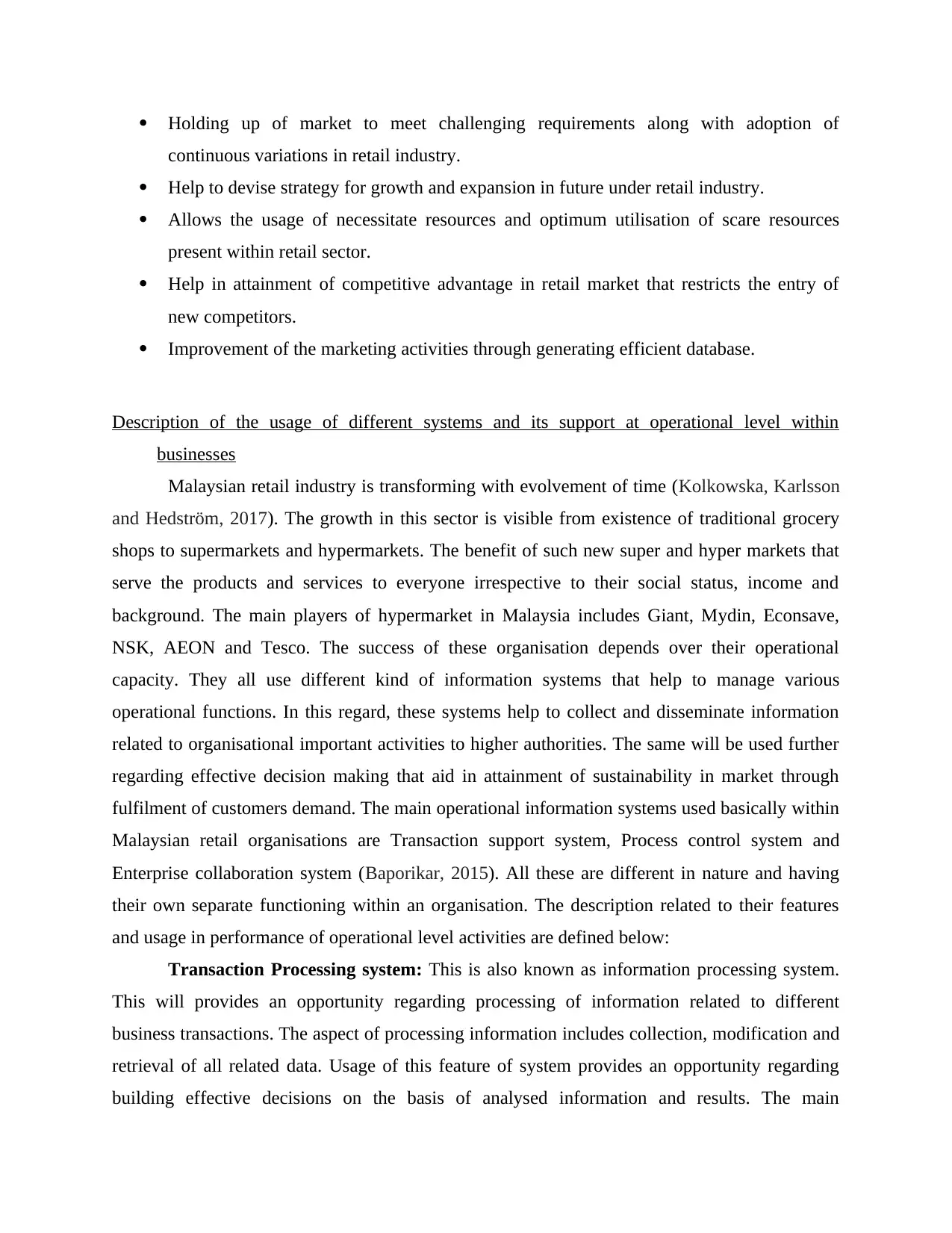
Holding up of market to meet challenging requirements along with adoption of
continuous variations in retail industry.
Help to devise strategy for growth and expansion in future under retail industry.
Allows the usage of necessitate resources and optimum utilisation of scare resources
present within retail sector.
Help in attainment of competitive advantage in retail market that restricts the entry of
new competitors.
Improvement of the marketing activities through generating efficient database.
Description of the usage of different systems and its support at operational level within
businesses
Malaysian retail industry is transforming with evolvement of time (Kolkowska, Karlsson
and Hedström, 2017). The growth in this sector is visible from existence of traditional grocery
shops to supermarkets and hypermarkets. The benefit of such new super and hyper markets that
serve the products and services to everyone irrespective to their social status, income and
background. The main players of hypermarket in Malaysia includes Giant, Mydin, Econsave,
NSK, AEON and Tesco. The success of these organisation depends over their operational
capacity. They all use different kind of information systems that help to manage various
operational functions. In this regard, these systems help to collect and disseminate information
related to organisational important activities to higher authorities. The same will be used further
regarding effective decision making that aid in attainment of sustainability in market through
fulfilment of customers demand. The main operational information systems used basically within
Malaysian retail organisations are Transaction support system, Process control system and
Enterprise collaboration system (Baporikar, 2015). All these are different in nature and having
their own separate functioning within an organisation. The description related to their features
and usage in performance of operational level activities are defined below:
Transaction Processing system: This is also known as information processing system.
This will provides an opportunity regarding processing of information related to different
business transactions. The aspect of processing information includes collection, modification and
retrieval of all related data. Usage of this feature of system provides an opportunity regarding
building effective decisions on the basis of analysed information and results. The main
continuous variations in retail industry.
Help to devise strategy for growth and expansion in future under retail industry.
Allows the usage of necessitate resources and optimum utilisation of scare resources
present within retail sector.
Help in attainment of competitive advantage in retail market that restricts the entry of
new competitors.
Improvement of the marketing activities through generating efficient database.
Description of the usage of different systems and its support at operational level within
businesses
Malaysian retail industry is transforming with evolvement of time (Kolkowska, Karlsson
and Hedström, 2017). The growth in this sector is visible from existence of traditional grocery
shops to supermarkets and hypermarkets. The benefit of such new super and hyper markets that
serve the products and services to everyone irrespective to their social status, income and
background. The main players of hypermarket in Malaysia includes Giant, Mydin, Econsave,
NSK, AEON and Tesco. The success of these organisation depends over their operational
capacity. They all use different kind of information systems that help to manage various
operational functions. In this regard, these systems help to collect and disseminate information
related to organisational important activities to higher authorities. The same will be used further
regarding effective decision making that aid in attainment of sustainability in market through
fulfilment of customers demand. The main operational information systems used basically within
Malaysian retail organisations are Transaction support system, Process control system and
Enterprise collaboration system (Baporikar, 2015). All these are different in nature and having
their own separate functioning within an organisation. The description related to their features
and usage in performance of operational level activities are defined below:
Transaction Processing system: This is also known as information processing system.
This will provides an opportunity regarding processing of information related to different
business transactions. The aspect of processing information includes collection, modification and
retrieval of all related data. Usage of this feature of system provides an opportunity regarding
building effective decisions on the basis of analysed information and results. The main
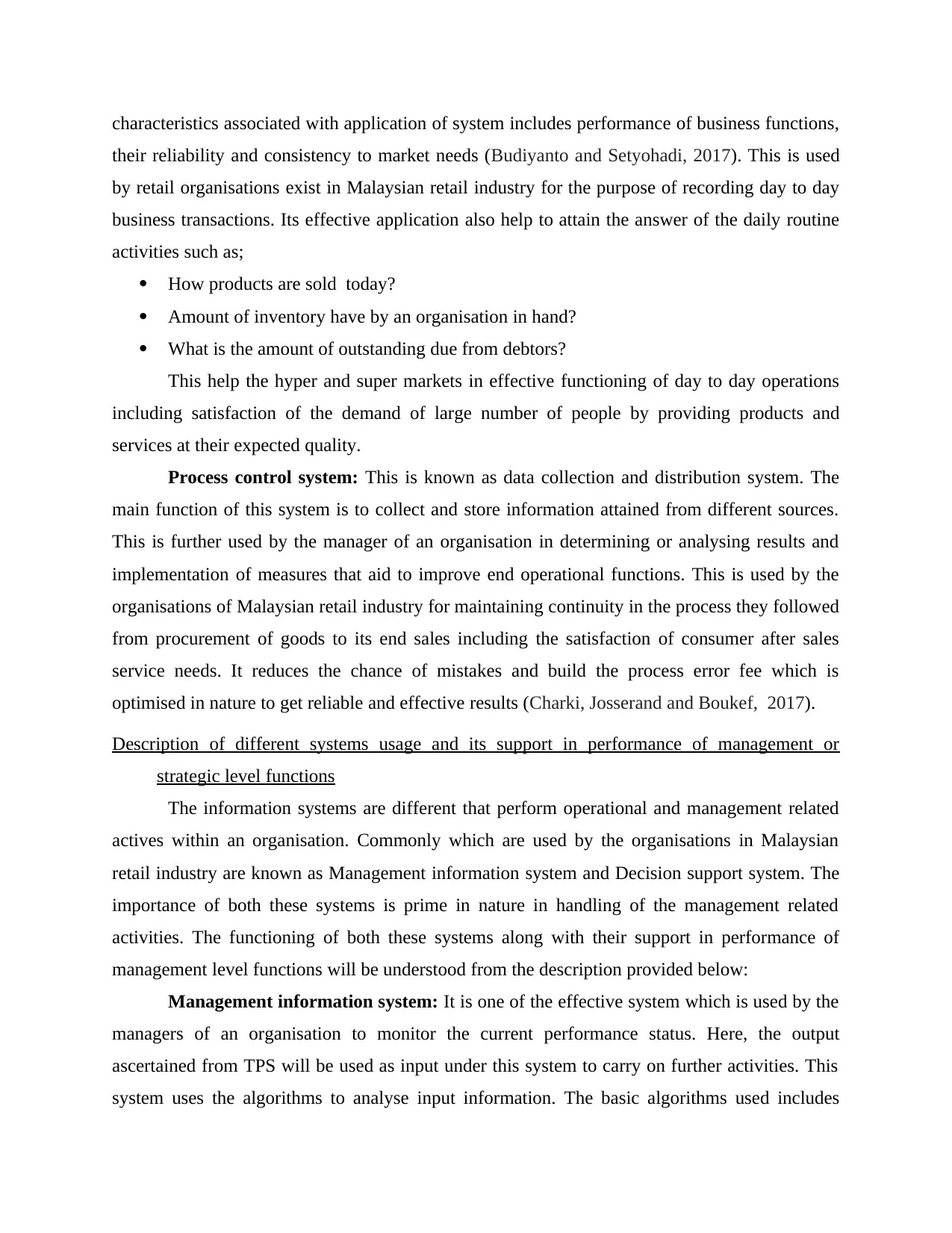
characteristics associated with application of system includes performance of business functions,
their reliability and consistency to market needs (Budiyanto and Setyohadi, 2017). This is used
by retail organisations exist in Malaysian retail industry for the purpose of recording day to day
business transactions. Its effective application also help to attain the answer of the daily routine
activities such as;
How products are sold today?
Amount of inventory have by an organisation in hand?
What is the amount of outstanding due from debtors?
This help the hyper and super markets in effective functioning of day to day operations
including satisfaction of the demand of large number of people by providing products and
services at their expected quality.
Process control system: This is known as data collection and distribution system. The
main function of this system is to collect and store information attained from different sources.
This is further used by the manager of an organisation in determining or analysing results and
implementation of measures that aid to improve end operational functions. This is used by the
organisations of Malaysian retail industry for maintaining continuity in the process they followed
from procurement of goods to its end sales including the satisfaction of consumer after sales
service needs. It reduces the chance of mistakes and build the process error fee which is
optimised in nature to get reliable and effective results (Charki, Josserand and Boukef, 2017).
Description of different systems usage and its support in performance of management or
strategic level functions
The information systems are different that perform operational and management related
actives within an organisation. Commonly which are used by the organisations in Malaysian
retail industry are known as Management information system and Decision support system. The
importance of both these systems is prime in nature in handling of the management related
activities. The functioning of both these systems along with their support in performance of
management level functions will be understood from the description provided below:
Management information system: It is one of the effective system which is used by the
managers of an organisation to monitor the current performance status. Here, the output
ascertained from TPS will be used as input under this system to carry on further activities. This
system uses the algorithms to analyse input information. The basic algorithms used includes
their reliability and consistency to market needs (Budiyanto and Setyohadi, 2017). This is used
by retail organisations exist in Malaysian retail industry for the purpose of recording day to day
business transactions. Its effective application also help to attain the answer of the daily routine
activities such as;
How products are sold today?
Amount of inventory have by an organisation in hand?
What is the amount of outstanding due from debtors?
This help the hyper and super markets in effective functioning of day to day operations
including satisfaction of the demand of large number of people by providing products and
services at their expected quality.
Process control system: This is known as data collection and distribution system. The
main function of this system is to collect and store information attained from different sources.
This is further used by the manager of an organisation in determining or analysing results and
implementation of measures that aid to improve end operational functions. This is used by the
organisations of Malaysian retail industry for maintaining continuity in the process they followed
from procurement of goods to its end sales including the satisfaction of consumer after sales
service needs. It reduces the chance of mistakes and build the process error fee which is
optimised in nature to get reliable and effective results (Charki, Josserand and Boukef, 2017).
Description of different systems usage and its support in performance of management or
strategic level functions
The information systems are different that perform operational and management related
actives within an organisation. Commonly which are used by the organisations in Malaysian
retail industry are known as Management information system and Decision support system. The
importance of both these systems is prime in nature in handling of the management related
activities. The functioning of both these systems along with their support in performance of
management level functions will be understood from the description provided below:
Management information system: It is one of the effective system which is used by the
managers of an organisation to monitor the current performance status. Here, the output
ascertained from TPS will be used as input under this system to carry on further activities. This
system uses the algorithms to analyse input information. The basic algorithms used includes
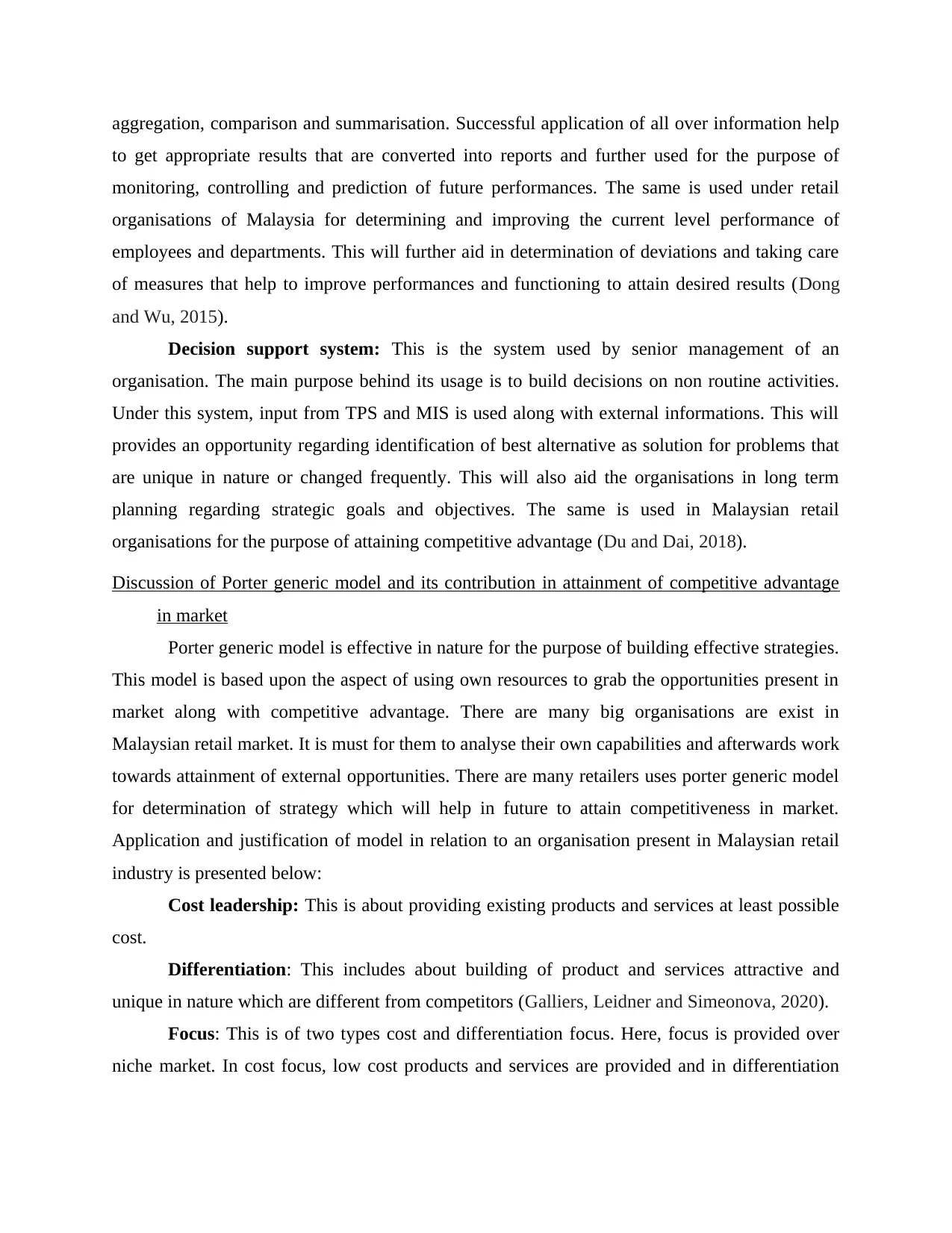
aggregation, comparison and summarisation. Successful application of all over information help
to get appropriate results that are converted into reports and further used for the purpose of
monitoring, controlling and prediction of future performances. The same is used under retail
organisations of Malaysia for determining and improving the current level performance of
employees and departments. This will further aid in determination of deviations and taking care
of measures that help to improve performances and functioning to attain desired results (Dong
and Wu, 2015).
Decision support system: This is the system used by senior management of an
organisation. The main purpose behind its usage is to build decisions on non routine activities.
Under this system, input from TPS and MIS is used along with external informations. This will
provides an opportunity regarding identification of best alternative as solution for problems that
are unique in nature or changed frequently. This will also aid the organisations in long term
planning regarding strategic goals and objectives. The same is used in Malaysian retail
organisations for the purpose of attaining competitive advantage (Du and Dai, 2018).
Discussion of Porter generic model and its contribution in attainment of competitive advantage
in market
Porter generic model is effective in nature for the purpose of building effective strategies.
This model is based upon the aspect of using own resources to grab the opportunities present in
market along with competitive advantage. There are many big organisations are exist in
Malaysian retail market. It is must for them to analyse their own capabilities and afterwards work
towards attainment of external opportunities. There are many retailers uses porter generic model
for determination of strategy which will help in future to attain competitiveness in market.
Application and justification of model in relation to an organisation present in Malaysian retail
industry is presented below:
Cost leadership: This is about providing existing products and services at least possible
cost.
Differentiation: This includes about building of product and services attractive and
unique in nature which are different from competitors (Galliers, Leidner and Simeonova, 2020).
Focus: This is of two types cost and differentiation focus. Here, focus is provided over
niche market. In cost focus, low cost products and services are provided and in differentiation
to get appropriate results that are converted into reports and further used for the purpose of
monitoring, controlling and prediction of future performances. The same is used under retail
organisations of Malaysia for determining and improving the current level performance of
employees and departments. This will further aid in determination of deviations and taking care
of measures that help to improve performances and functioning to attain desired results (Dong
and Wu, 2015).
Decision support system: This is the system used by senior management of an
organisation. The main purpose behind its usage is to build decisions on non routine activities.
Under this system, input from TPS and MIS is used along with external informations. This will
provides an opportunity regarding identification of best alternative as solution for problems that
are unique in nature or changed frequently. This will also aid the organisations in long term
planning regarding strategic goals and objectives. The same is used in Malaysian retail
organisations for the purpose of attaining competitive advantage (Du and Dai, 2018).
Discussion of Porter generic model and its contribution in attainment of competitive advantage
in market
Porter generic model is effective in nature for the purpose of building effective strategies.
This model is based upon the aspect of using own resources to grab the opportunities present in
market along with competitive advantage. There are many big organisations are exist in
Malaysian retail market. It is must for them to analyse their own capabilities and afterwards work
towards attainment of external opportunities. There are many retailers uses porter generic model
for determination of strategy which will help in future to attain competitiveness in market.
Application and justification of model in relation to an organisation present in Malaysian retail
industry is presented below:
Cost leadership: This is about providing existing products and services at least possible
cost.
Differentiation: This includes about building of product and services attractive and
unique in nature which are different from competitors (Galliers, Leidner and Simeonova, 2020).
Focus: This is of two types cost and differentiation focus. Here, focus is provided over
niche market. In cost focus, low cost products and services are provided and in differentiation
Paraphrase This Document
Need a fresh take? Get an instant paraphrase of this document with our AI Paraphraser
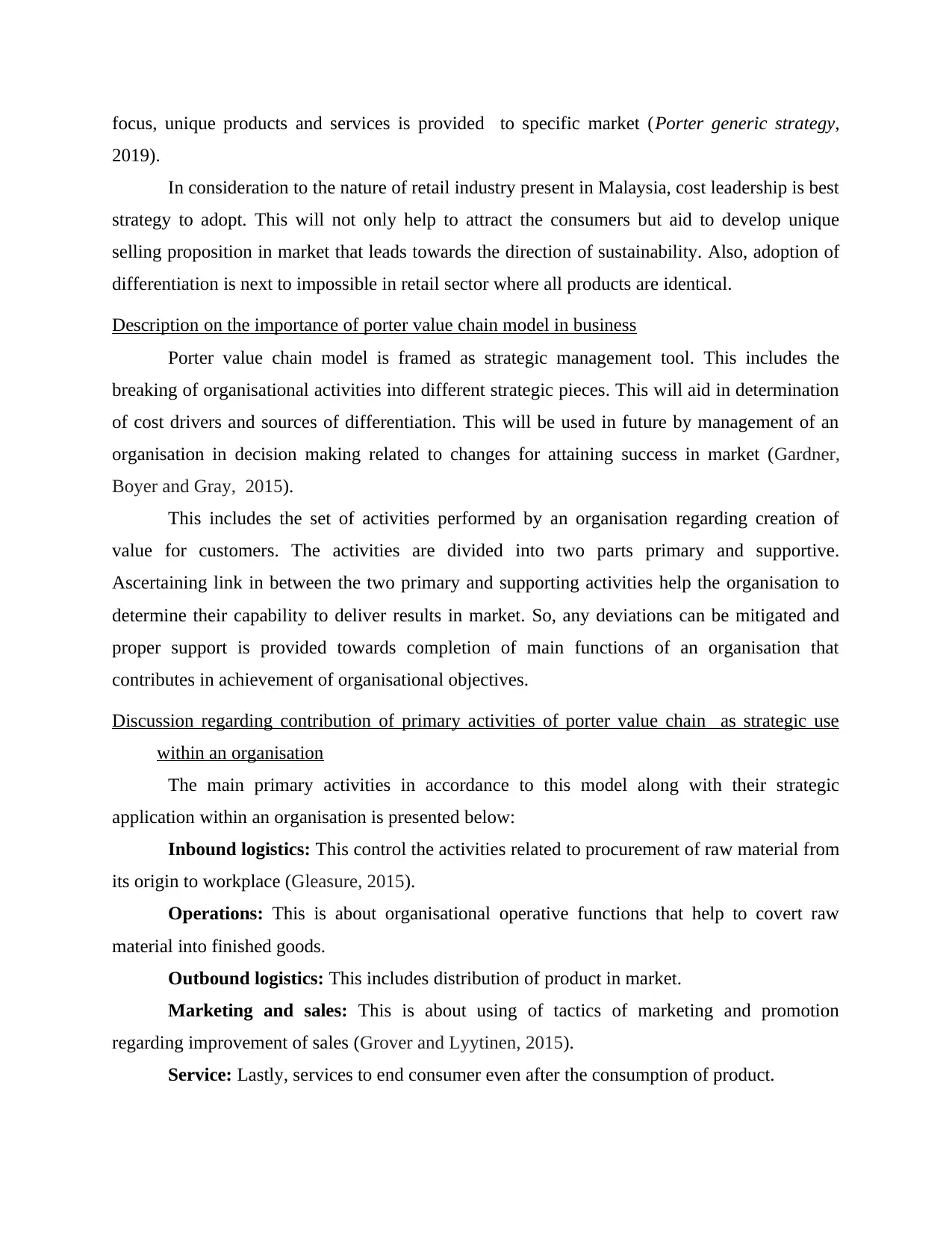
focus, unique products and services is provided to specific market (Porter generic strategy,
2019).
In consideration to the nature of retail industry present in Malaysia, cost leadership is best
strategy to adopt. This will not only help to attract the consumers but aid to develop unique
selling proposition in market that leads towards the direction of sustainability. Also, adoption of
differentiation is next to impossible in retail sector where all products are identical.
Description on the importance of porter value chain model in business
Porter value chain model is framed as strategic management tool. This includes the
breaking of organisational activities into different strategic pieces. This will aid in determination
of cost drivers and sources of differentiation. This will be used in future by management of an
organisation in decision making related to changes for attaining success in market (Gardner,
Boyer and Gray, 2015).
This includes the set of activities performed by an organisation regarding creation of
value for customers. The activities are divided into two parts primary and supportive.
Ascertaining link in between the two primary and supporting activities help the organisation to
determine their capability to deliver results in market. So, any deviations can be mitigated and
proper support is provided towards completion of main functions of an organisation that
contributes in achievement of organisational objectives.
Discussion regarding contribution of primary activities of porter value chain as strategic use
within an organisation
The main primary activities in accordance to this model along with their strategic
application within an organisation is presented below:
Inbound logistics: This control the activities related to procurement of raw material from
its origin to workplace (Gleasure, 2015).
Operations: This is about organisational operative functions that help to covert raw
material into finished goods.
Outbound logistics: This includes distribution of product in market.
Marketing and sales: This is about using of tactics of marketing and promotion
regarding improvement of sales (Grover and Lyytinen, 2015).
Service: Lastly, services to end consumer even after the consumption of product.
2019).
In consideration to the nature of retail industry present in Malaysia, cost leadership is best
strategy to adopt. This will not only help to attract the consumers but aid to develop unique
selling proposition in market that leads towards the direction of sustainability. Also, adoption of
differentiation is next to impossible in retail sector where all products are identical.
Description on the importance of porter value chain model in business
Porter value chain model is framed as strategic management tool. This includes the
breaking of organisational activities into different strategic pieces. This will aid in determination
of cost drivers and sources of differentiation. This will be used in future by management of an
organisation in decision making related to changes for attaining success in market (Gardner,
Boyer and Gray, 2015).
This includes the set of activities performed by an organisation regarding creation of
value for customers. The activities are divided into two parts primary and supportive.
Ascertaining link in between the two primary and supporting activities help the organisation to
determine their capability to deliver results in market. So, any deviations can be mitigated and
proper support is provided towards completion of main functions of an organisation that
contributes in achievement of organisational objectives.
Discussion regarding contribution of primary activities of porter value chain as strategic use
within an organisation
The main primary activities in accordance to this model along with their strategic
application within an organisation is presented below:
Inbound logistics: This control the activities related to procurement of raw material from
its origin to workplace (Gleasure, 2015).
Operations: This is about organisational operative functions that help to covert raw
material into finished goods.
Outbound logistics: This includes distribution of product in market.
Marketing and sales: This is about using of tactics of marketing and promotion
regarding improvement of sales (Grover and Lyytinen, 2015).
Service: Lastly, services to end consumer even after the consumption of product.
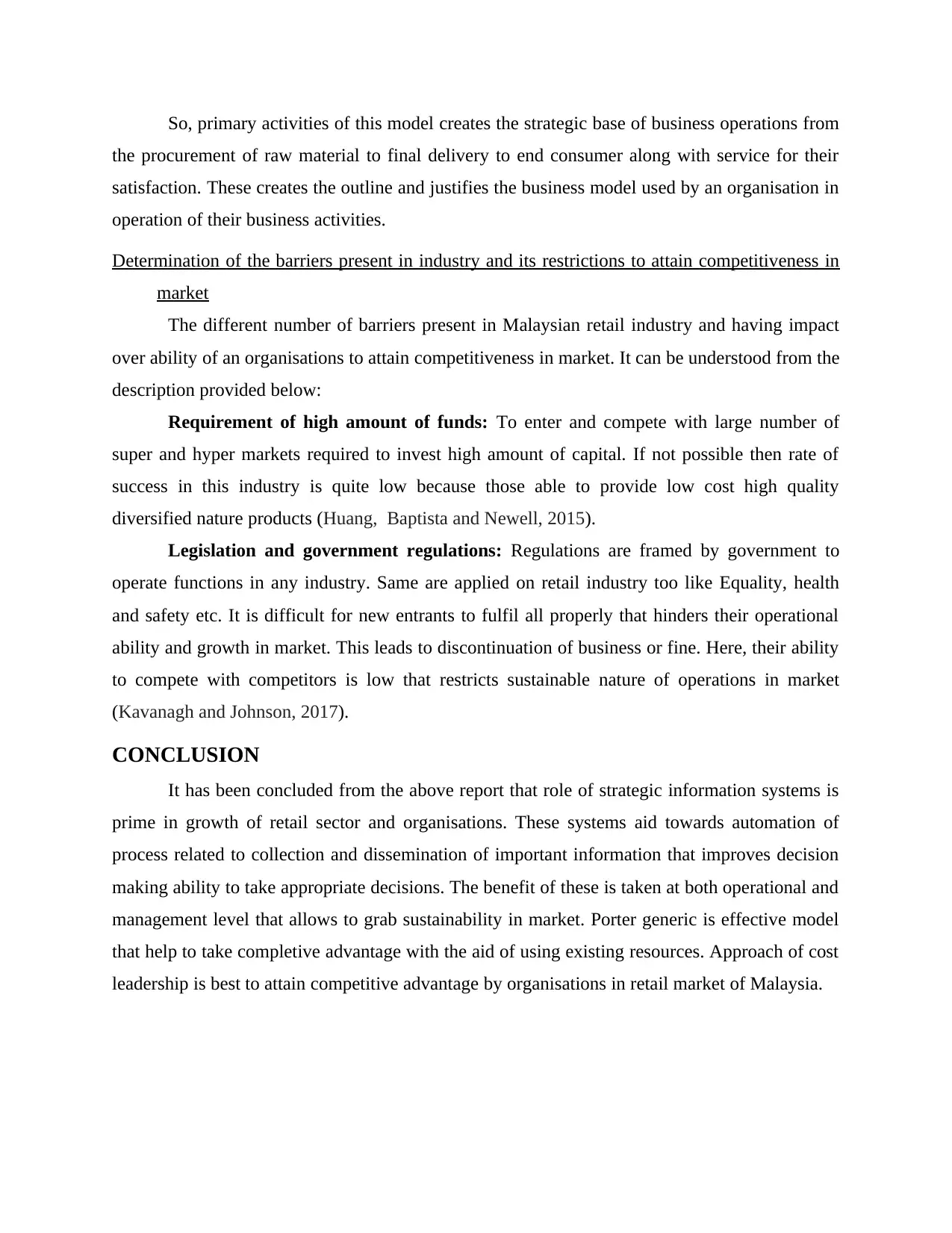
So, primary activities of this model creates the strategic base of business operations from
the procurement of raw material to final delivery to end consumer along with service for their
satisfaction. These creates the outline and justifies the business model used by an organisation in
operation of their business activities.
Determination of the barriers present in industry and its restrictions to attain competitiveness in
market
The different number of barriers present in Malaysian retail industry and having impact
over ability of an organisations to attain competitiveness in market. It can be understood from the
description provided below:
Requirement of high amount of funds: To enter and compete with large number of
super and hyper markets required to invest high amount of capital. If not possible then rate of
success in this industry is quite low because those able to provide low cost high quality
diversified nature products (Huang, Baptista and Newell, 2015).
Legislation and government regulations: Regulations are framed by government to
operate functions in any industry. Same are applied on retail industry too like Equality, health
and safety etc. It is difficult for new entrants to fulfil all properly that hinders their operational
ability and growth in market. This leads to discontinuation of business or fine. Here, their ability
to compete with competitors is low that restricts sustainable nature of operations in market
(Kavanagh and Johnson, 2017).
CONCLUSION
It has been concluded from the above report that role of strategic information systems is
prime in growth of retail sector and organisations. These systems aid towards automation of
process related to collection and dissemination of important information that improves decision
making ability to take appropriate decisions. The benefit of these is taken at both operational and
management level that allows to grab sustainability in market. Porter generic is effective model
that help to take completive advantage with the aid of using existing resources. Approach of cost
leadership is best to attain competitive advantage by organisations in retail market of Malaysia.
the procurement of raw material to final delivery to end consumer along with service for their
satisfaction. These creates the outline and justifies the business model used by an organisation in
operation of their business activities.
Determination of the barriers present in industry and its restrictions to attain competitiveness in
market
The different number of barriers present in Malaysian retail industry and having impact
over ability of an organisations to attain competitiveness in market. It can be understood from the
description provided below:
Requirement of high amount of funds: To enter and compete with large number of
super and hyper markets required to invest high amount of capital. If not possible then rate of
success in this industry is quite low because those able to provide low cost high quality
diversified nature products (Huang, Baptista and Newell, 2015).
Legislation and government regulations: Regulations are framed by government to
operate functions in any industry. Same are applied on retail industry too like Equality, health
and safety etc. It is difficult for new entrants to fulfil all properly that hinders their operational
ability and growth in market. This leads to discontinuation of business or fine. Here, their ability
to compete with competitors is low that restricts sustainable nature of operations in market
(Kavanagh and Johnson, 2017).
CONCLUSION
It has been concluded from the above report that role of strategic information systems is
prime in growth of retail sector and organisations. These systems aid towards automation of
process related to collection and dissemination of important information that improves decision
making ability to take appropriate decisions. The benefit of these is taken at both operational and
management level that allows to grab sustainability in market. Porter generic is effective model
that help to take completive advantage with the aid of using existing resources. Approach of cost
leadership is best to attain competitive advantage by organisations in retail market of Malaysia.
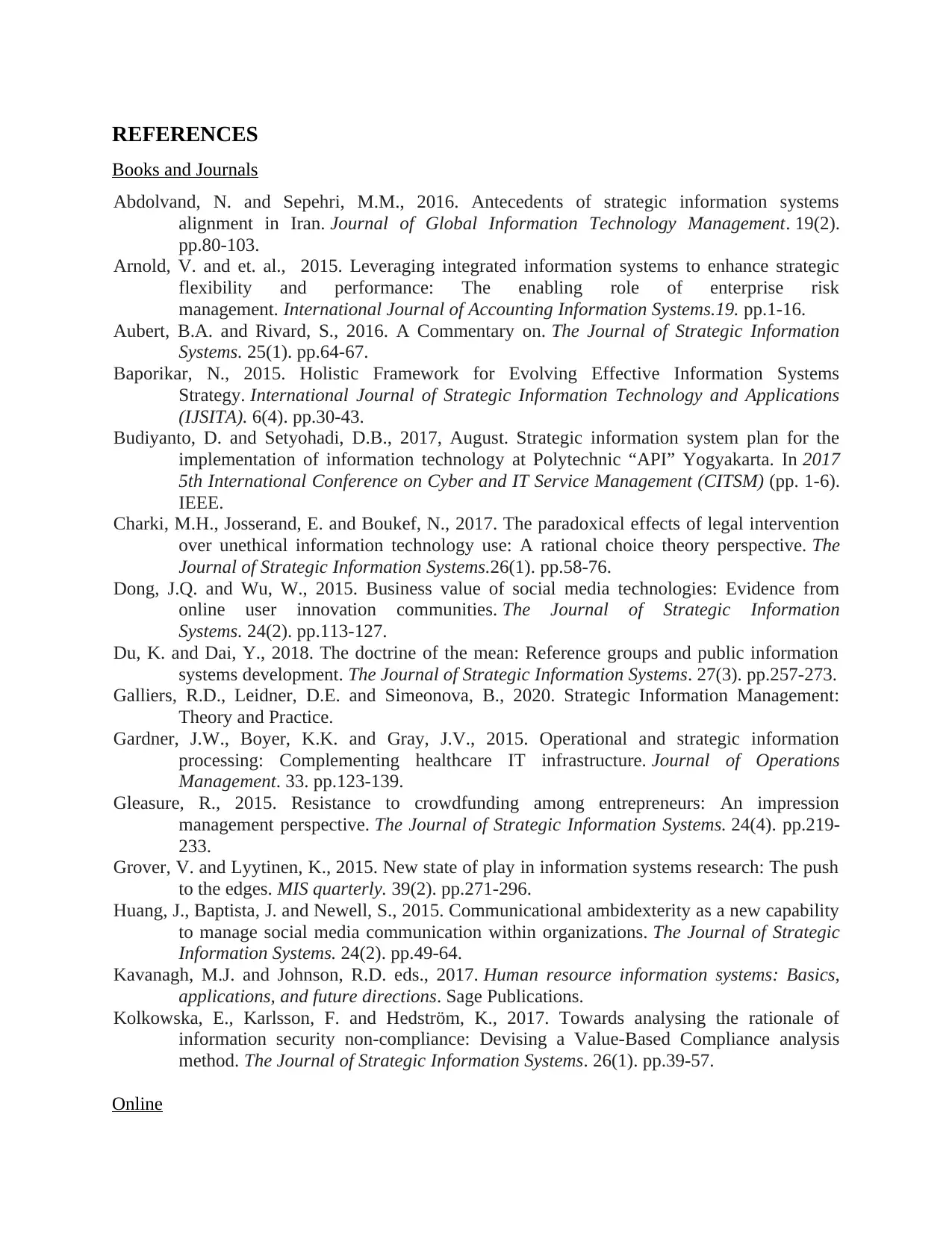
REFERENCES
Books and Journals
Abdolvand, N. and Sepehri, M.M., 2016. Antecedents of strategic information systems
alignment in Iran. Journal of Global Information Technology Management. 19(2).
pp.80-103.
Arnold, V. and et. al., 2015. Leveraging integrated information systems to enhance strategic
flexibility and performance: The enabling role of enterprise risk
management. International Journal of Accounting Information Systems.19. pp.1-16.
Aubert, B.A. and Rivard, S., 2016. A Commentary on. The Journal of Strategic Information
Systems. 25(1). pp.64-67.
Baporikar, N., 2015. Holistic Framework for Evolving Effective Information Systems
Strategy. International Journal of Strategic Information Technology and Applications
(IJSITA). 6(4). pp.30-43.
Budiyanto, D. and Setyohadi, D.B., 2017, August. Strategic information system plan for the
implementation of information technology at Polytechnic “API” Yogyakarta. In 2017
5th International Conference on Cyber and IT Service Management (CITSM) (pp. 1-6).
IEEE.
Charki, M.H., Josserand, E. and Boukef, N., 2017. The paradoxical effects of legal intervention
over unethical information technology use: A rational choice theory perspective. The
Journal of Strategic Information Systems.26(1). pp.58-76.
Dong, J.Q. and Wu, W., 2015. Business value of social media technologies: Evidence from
online user innovation communities. The Journal of Strategic Information
Systems. 24(2). pp.113-127.
Du, K. and Dai, Y., 2018. The doctrine of the mean: Reference groups and public information
systems development. The Journal of Strategic Information Systems. 27(3). pp.257-273.
Galliers, R.D., Leidner, D.E. and Simeonova, B., 2020. Strategic Information Management:
Theory and Practice.
Gardner, J.W., Boyer, K.K. and Gray, J.V., 2015. Operational and strategic information
processing: Complementing healthcare IT infrastructure. Journal of Operations
Management. 33. pp.123-139.
Gleasure, R., 2015. Resistance to crowdfunding among entrepreneurs: An impression
management perspective. The Journal of Strategic Information Systems. 24(4). pp.219-
233.
Grover, V. and Lyytinen, K., 2015. New state of play in information systems research: The push
to the edges. MIS quarterly. 39(2). pp.271-296.
Huang, J., Baptista, J. and Newell, S., 2015. Communicational ambidexterity as a new capability
to manage social media communication within organizations. The Journal of Strategic
Information Systems. 24(2). pp.49-64.
Kavanagh, M.J. and Johnson, R.D. eds., 2017. Human resource information systems: Basics,
applications, and future directions. Sage Publications.
Kolkowska, E., Karlsson, F. and Hedström, K., 2017. Towards analysing the rationale of
information security non-compliance: Devising a Value-Based Compliance analysis
method. The Journal of Strategic Information Systems. 26(1). pp.39-57.
Online
Books and Journals
Abdolvand, N. and Sepehri, M.M., 2016. Antecedents of strategic information systems
alignment in Iran. Journal of Global Information Technology Management. 19(2).
pp.80-103.
Arnold, V. and et. al., 2015. Leveraging integrated information systems to enhance strategic
flexibility and performance: The enabling role of enterprise risk
management. International Journal of Accounting Information Systems.19. pp.1-16.
Aubert, B.A. and Rivard, S., 2016. A Commentary on. The Journal of Strategic Information
Systems. 25(1). pp.64-67.
Baporikar, N., 2015. Holistic Framework for Evolving Effective Information Systems
Strategy. International Journal of Strategic Information Technology and Applications
(IJSITA). 6(4). pp.30-43.
Budiyanto, D. and Setyohadi, D.B., 2017, August. Strategic information system plan for the
implementation of information technology at Polytechnic “API” Yogyakarta. In 2017
5th International Conference on Cyber and IT Service Management (CITSM) (pp. 1-6).
IEEE.
Charki, M.H., Josserand, E. and Boukef, N., 2017. The paradoxical effects of legal intervention
over unethical information technology use: A rational choice theory perspective. The
Journal of Strategic Information Systems.26(1). pp.58-76.
Dong, J.Q. and Wu, W., 2015. Business value of social media technologies: Evidence from
online user innovation communities. The Journal of Strategic Information
Systems. 24(2). pp.113-127.
Du, K. and Dai, Y., 2018. The doctrine of the mean: Reference groups and public information
systems development. The Journal of Strategic Information Systems. 27(3). pp.257-273.
Galliers, R.D., Leidner, D.E. and Simeonova, B., 2020. Strategic Information Management:
Theory and Practice.
Gardner, J.W., Boyer, K.K. and Gray, J.V., 2015. Operational and strategic information
processing: Complementing healthcare IT infrastructure. Journal of Operations
Management. 33. pp.123-139.
Gleasure, R., 2015. Resistance to crowdfunding among entrepreneurs: An impression
management perspective. The Journal of Strategic Information Systems. 24(4). pp.219-
233.
Grover, V. and Lyytinen, K., 2015. New state of play in information systems research: The push
to the edges. MIS quarterly. 39(2). pp.271-296.
Huang, J., Baptista, J. and Newell, S., 2015. Communicational ambidexterity as a new capability
to manage social media communication within organizations. The Journal of Strategic
Information Systems. 24(2). pp.49-64.
Kavanagh, M.J. and Johnson, R.D. eds., 2017. Human resource information systems: Basics,
applications, and future directions. Sage Publications.
Kolkowska, E., Karlsson, F. and Hedström, K., 2017. Towards analysing the rationale of
information security non-compliance: Devising a Value-Based Compliance analysis
method. The Journal of Strategic Information Systems. 26(1). pp.39-57.
Online
Secure Best Marks with AI Grader
Need help grading? Try our AI Grader for instant feedback on your assignments.
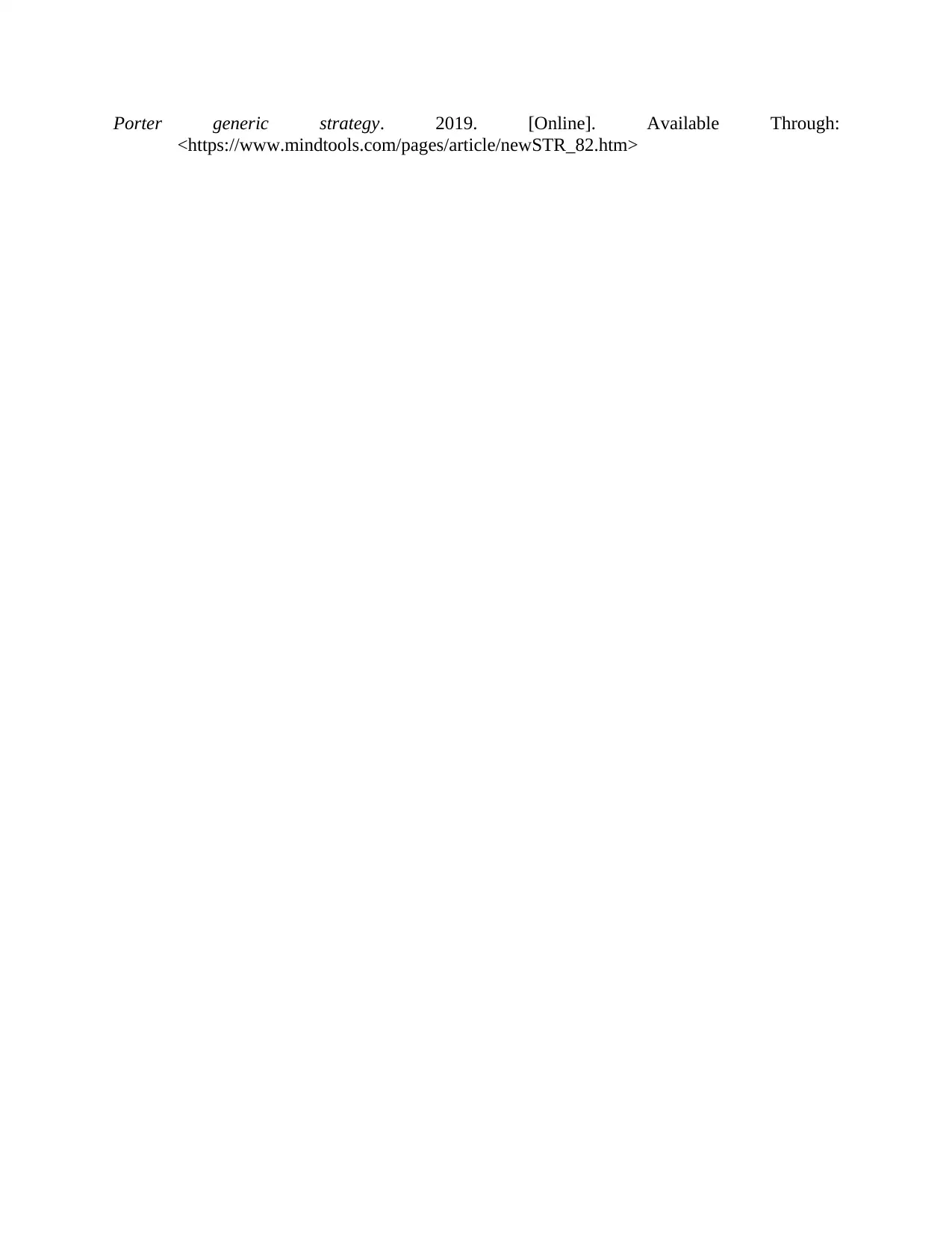
Porter generic strategy. 2019. [Online]. Available Through:
<https://www.mindtools.com/pages/article/newSTR_82.htm>
<https://www.mindtools.com/pages/article/newSTR_82.htm>
1 out of 11
Related Documents
Your All-in-One AI-Powered Toolkit for Academic Success.
+13062052269
info@desklib.com
Available 24*7 on WhatsApp / Email
![[object Object]](/_next/static/media/star-bottom.7253800d.svg)
Unlock your academic potential
© 2024 | Zucol Services PVT LTD | All rights reserved.





